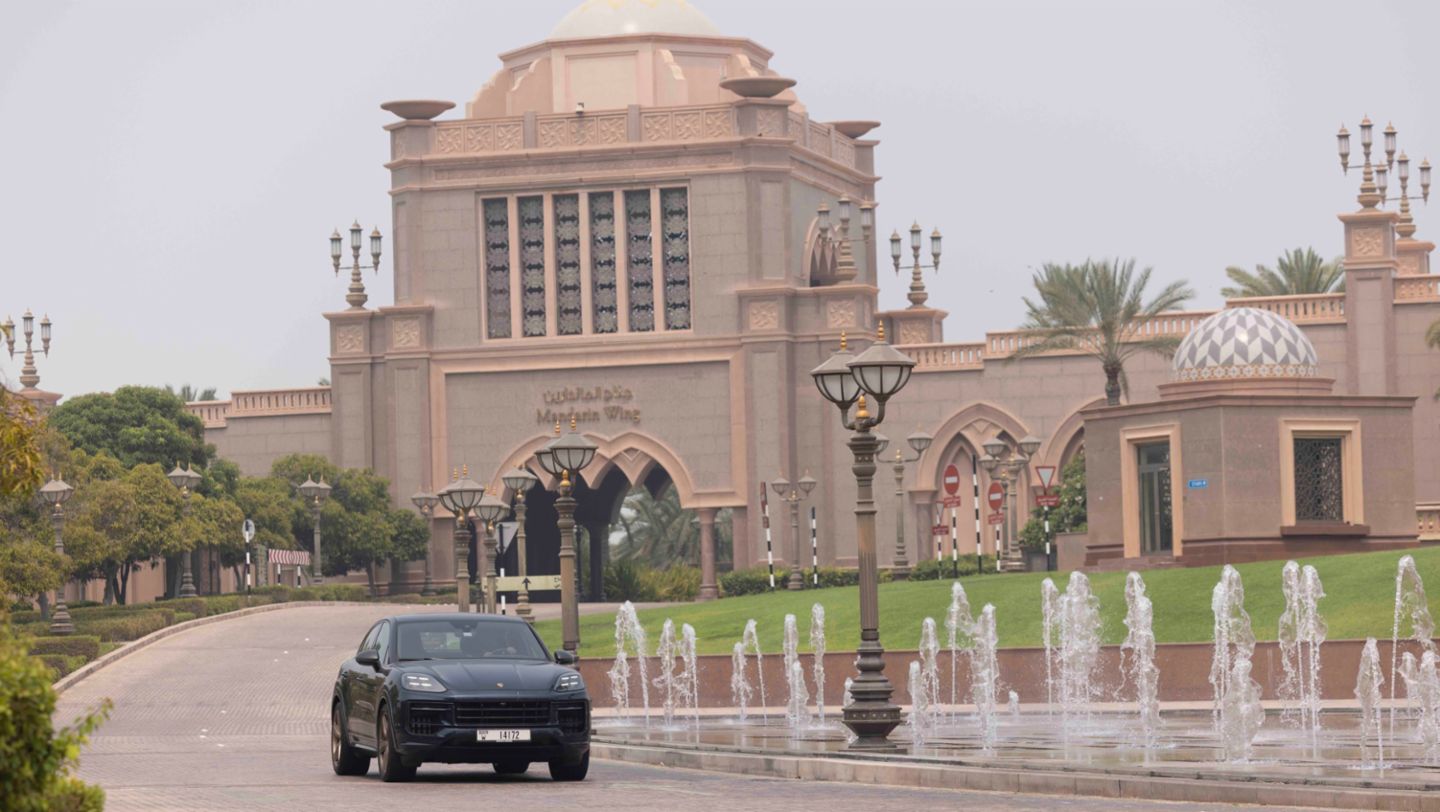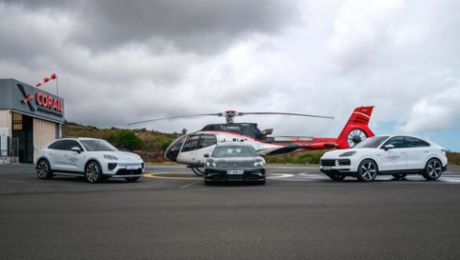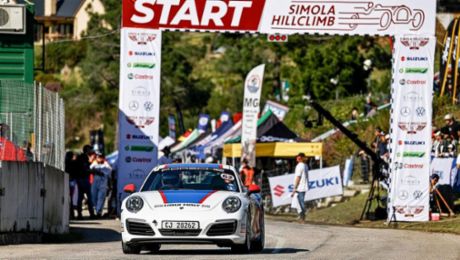It’s not every day you get to visit a country that’s just a few years older than you are yourself. When the large oil reserves were discovered in 1971, the seven emirates joined together to form the desert country, which has since developed into one of the most modern and wealthiest regions in the world – and there’s no end in sight.
Tradition and innovation united
During our visit, we discover a country that is ultramodern and perfectly organized, and yet shaped by a culture spanning millennia. Over the decades, this contrast, in particular, has allowed the United Arab Emirates to develop into a popular vacation destination. We’re completing our road trip through the seven emirates in the Porsche Cayenne S Coupé, which, like the country, unites tradition and innovation.
Our journey begins in the Emirate of Dubai, whose megacity of the same name is the capital city and a global center of trade and transport with enormous economic power. Dubai is the most populous city in the UAE and a melting pot of cultures with a lively expat community. Around 3.5 million people from all over the world live here, where the everyday language is English. The irony is that we don’t see many people out on the streets when we begin our tour. But that’s to be expected in the summer months, when temperatures exceed 40 degrees Celsius and humidity is extraordinarily high.
Superlatives in the desert country
The best time to visit is the winter months, with high temperatures ranging from 24 to 27 degrees Celsius. But whether it’s summer or winter, a drive through Dubai’s skyscraper canyons is a sightseeing tour in and of itself, with a new highlight around just about every corner, from the Burj Khalifa, which at 828 meters is the tallest building in the world, and Dubai Mall, which is the world’s largest shopping center, to the largest indoor toboggan run and the largest ski hall. Here in the desert country, you’ll discover one superlative after the other.
We have an appointment with French chef Grégoire Berger in Palm Jumeirah, the largest archipelago of artificial islands directly on the Persian Gulf. Berger works at Ossiano, the underwater restaurant that belongs to the five-star hotel Atlantis, The Palm and has a Michelin Star. “Dubai is like a futuristic city in a science fiction movie, where people of different ethnicities and cultural backgrounds live together in peace,” says Berger, who has four toques in the Gault&Millau guide and has been living and working in Dubai for the past 10 years.
Every evening he takes guests on a fine-dining journey of 11 courses inspired by the location’s culinary diversity. “It’s not like in France, where we have a history of cooking culture that goes back centuries. This region was home to nomads just a few decades ago. Cooking was not an art, but a means of survival.” Then all the different nationalities and their influences came together – Arabic, Persian, Indian, and African. The result is an astonishing cuisine. “You won’t find what we’re doing here anywhere else in the world!”
Exciting contrasts
It’s like starting with a blank slate, which offers endless opportunity, but occasionally also results in some curiosities. For instance, neighborhoods such as Internet City, Studio City, and Healthcare City are pragmatically named after the industries that have settled there. And where there’s no natural history, a helping hand can make all the difference. Take the area of Al Seef, which with its bazaars and souks was only developed in 2017, but feels much like a piece of history. We’ll discover unique and exciting things like this time and again throughout our journey.

Our 677-kilometer tour through the seven emirates begins with a drive from the megacity to the Emirate of Sharjah, which borders Dubai to the north.
It doesn’t take long for the surroundings to change entirely, from endless rows of fascinating skyscrapers to a flat, vast landscape. Visible on both sides of the road are the occasional settlement with light-colored houses, plenty of mosques, lots of sand and stones, a range of colors from yellowish to red – and endless expanses all around. UAE owes its unparalleled economic growth to its reserves of natural gas and petroleum. But as a progressive country, it has also invested heavily in solar energy in recent years. And thanks to innovative irrigation technologies and desalination plants, the populated regions are surprisingly lush despite the dry climate and can grow a variety of fruits and vegetables.
Along the Persian Gulf
During our drive through the Emirates of Ajman and Umm al-Qaiwain, we have the opportunity to marvel at the beautiful sandy beaches and dense forests of mangrove along the Persian Gulf as well as experience traditional trade activities at souks and fish markets, before stopping in Ras al-Khaimah, where we get a taste of the traditional cuisine of the northernmost emirate. The restaurant Madfoon Al Sadda serves up a meal of chicken, goat, lamb, and shrimp, with spices like cinnamon, ginger, saffron, turmeric, and curry creating an explosion of flavor. Side dishes include rice and a salad with pomegranate seeds, date syrup, and sumac for a little extra kick. After the meal, we enjoy an Arabic coffee with cardamom. Our morning in the futuristic flair of Dubai is followed by an evening of traditional cuisine in a country that embodies both tradition and modernity.
We continue our journey and head for the heart of the country. Ahead of us is Jebel Jais mountain, whose summit at 1,934 meters forms the highest point in the country. On our way there, the landscape grows more mountainous.
Paradisiacal calm
Although it makes perfect sense, we’d never have thought it possible after such an endless expanse. Before you know it, you’re surrounded by an imposing panorama of mountain ridges and peaks. The silhouette is extraordinary, especially with the sky hazy as it is now. The area looks like a brownish-grey lunar landscape of layered cliffs. But that doesn’t have any impact on the driving fun, as the four-lane road is in excellent condition here, too – and largely void of any other cars.
Despite the vertical cliff walls bordering the winding road on both sides, we feel snug as a bug in the Cayenne S. The eight-speed automatic transmission and the Porsche Traction Management distributes the 474 PS from the four-liter V8 engine among all four wheels as required.
The optional adaptive air suspension and electronically controlled shock absorbers compensate for every bump, and the precise steering makes you feel like you’re connected directly to the road. The Cayenne really demonstrates its sporty DNA on the curves, too, as torque vectoring and active roll stabilization maintain stability and agility at all times. Even sudden changes of direction cannot disturb the peace and quiet inside the car. And speaking of peace and quiet: there’s a paradisiacal calm up here.
From the last vantage point just below the peak, we take in the breathtaking view. The border to Oman must be back there somewhere – and a little further down is our next destination, Khor Fakkan on the eastern coast, which is known for its beaches, snorkeling, and watersport activities. The city is surrounded by the Emirate of Fujairah, but is an exclave of Sharjah.
The region along the eastern coast has long been shaped by its relationship with the water. Pearl trade was the primary source of income for centuries, and many families made a living with pearl diving. While the introduction of cultured pearls in the 1930s drastically reduced trade with natural pearls, the tradition and history of pearl diving are deeply rooted in the culture of the UAE. And pearl divers still exist to this day – like Mohamad, who works for a farming company. Opening oysters is still a very special moment for him. “Farming takes two years, and then we have a 60% chance of success. It used to be one in a thousand!”
We spend a wonderfully relaxing day at the beach in Khor Fakkan, with the Gulf of Oman in front of us and the Hajar Mountains behind us. Built directly on the beach promenade, the imposing amphitheater is designed to look ancient like the souks in Dubai and features an artificial waterfall, but that doesn’t make it any less impressive. The country offers more than enough historical locations, though they are often less conspicuous.
Take for example Al Bidya Mosque, just a 10-minute drive from Khor Fakkan. Built in the 15th century, this small mud building is the second-oldest mosque in the United Arab Emirates and of significant historical value.
History is tangible
This history is also tangible during our next stop at Najd al-Maqsar village, located to the west of Khor Fakkan in the Hajar Mountains. We come to a stop in front of the imposing mountain village built here in the heart of a riverbed nearly 300 years ago. Following extensive restoration, this perfectly maintained settlement is something to behold and offers a breathtaking view. Its stone and mud walls and roofs made from palm fronds only add to the ancient flair. We pause for just a moment to enjoy this panorama before resuming our journey back toward the western coast.
Along the way, we make a stop in Hatta, an exclave of the Emirate of Dubai. It’s comparatively tranquil here in the heart of the Hajar Mountains. We marvel at the old hilltop village with its two imposing watchtowers from the 1880s and a reservoir surrounded by massive cliff walls further down on the plain. We recharge our batteries for the final leg of our journey and then head for the megacity Abu Dhabi, which is the capital city of both the country and the emirate of the same name.

Abu Dhabi is not only the wealthiest of the seven emirates, but also the largest, as it accounts for 87% of the country’s total land area. Positioned directly on the shores of the Persian Gulf, Emirates Palace is much like a manifestation of this wealth in stone form. The luxury hotel opened its doors in 2005 and features 302 rooms, 92 suites, 10 restaurants, and a connected resort. “It took four years to build, and a team of 20,000 workers,” explains Aariff Nazeem, Operations Manager at Emirates Palace. “Zayed, the sheikh at that time, was seen as the father of the nation. He wanted to build a palace where guests could feel like queens and kings for a day.” The largest suites are almost 700 square meters in size. Emirates Palace is also a publicly accessible tourist attraction.
Striking impressions
Like Dubai, Abu Dhabi is located directly by the sea and boasts an impressive skyline. And like Dubai, the city is rich in culture and diversity and home to iconic attractions like the Sheikh Zayed Grand Mosque, the Louvre Abu Dhabi art museum, and the Corniche, a beach promenade offering a whole host of recreational activities. While Abu Dhabi is a city full of striking impressions, our journey comes to an end in nature.
Two and a half hours later, we find ourselves in the majestic middle of nowhere. The Rubʿ al-Khali desert measures about 680,000 square kilometers in size, making it the world’s largest continuous sand desert, and extends into four countries: the United Arab Emirates, Saudi Arabia, Oman, and Yemen. We stop at the sand dunes of Liwa, some of which are nearly 300 meters tall, along the border to Saudi Arabia and watch as the sunset bathes them in a deep red.

A herd of camels can be seen off in the distance. A moment of joy and the end to a journey that begs for a sequel, for example next weekend, when the final race of the FIA WEC season starts in Bahrain.
Or for the 'Icons of Porsche' festival in Dubai. From 23 to 24 November this event is a celebration of the interplay between tradition and modernity and brings nearly 30,000 fans of classic Porsche cars, art, and culture together in the metropolitan city. That’s more than enough reason to return to the country of exciting contrasts. After all, there’s still so much we haven’t seen.
Info
Text first published in Christophorus Magazine, issue 412.
Text: Nico Cramer
Photos: Naim Chidiac
Copyright: All images, videos and audio files published in this article are subject to copyright. Reproduction in whole or in part is not permitted without the written consent of Dr. Ing. h.c. F. Porsche AG. Please contact newsroom@porsche.com for further information.

























.jpg/jcr:content/2696_yob_bts_AKOS8388_edit_V02_2048px%20(2).jpg)